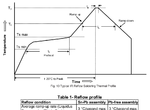T
treez
Guest
Do you agree…MCPCB is good for eg LEDs when all things mounted on the MCPCB are the same component…but having say an SMPS power fets and control board mounted on MCPCB would be a mistake…because the chances of all those different components being correctly soldered on MCPCB is very slim.
I worked at an electric drives place, and they had mounted the entire electric drive control circuit and igbts and output caps etc on the same piece of MCPCB, and all the boards needed reworking as many components were not correctly soldered…even when reworking , it was pretty well impossible to get all the different components soldered onto the MCPCB.
Do you agree.. MCPCB is really only for when all the components to be mounted are the same?
I worked at an electric drives place, and they had mounted the entire electric drive control circuit and igbts and output caps etc on the same piece of MCPCB, and all the boards needed reworking as many components were not correctly soldered…even when reworking , it was pretty well impossible to get all the different components soldered onto the MCPCB.
Do you agree.. MCPCB is really only for when all the components to be mounted are the same?
